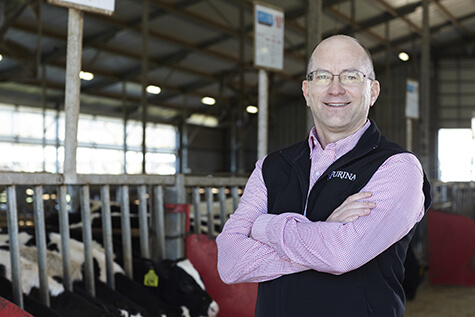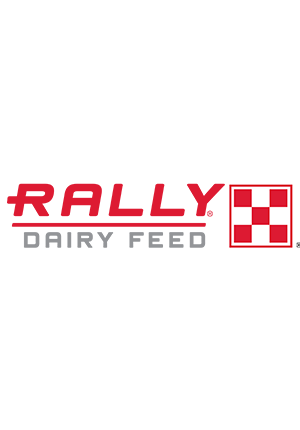
Could You Get More from Your Dairy Feed Ration?
Cow : Lactating Cow Nutrition
Cow : Transition Cow Nutrition
Peak milk production drives your lactating herd’s performance. Ensuring you have the nutrients available to support these stages of lactation is key to making your dairy cow feeding program efficient and improving your income over feed cost (IOFC) potential.
A targeted dairy feed ration approach allows you to prioritize and invest in more profitable, early lactation cows and cut back on less profitable cows later in lactation.
See how Oak Spring Farms found cost efficiencies through targeted rations.
Here are a few areas to consider when trying to get the most from your dairy feed rations:
A separate fresh cow diet for the first 30-40 days in milk allows you to invest in nutrients, technologies and feed additives specific to fresh cows. Early lactation cows benefit from these the most, and a targeted feed ration can help you deliver what they need without wasting dollars on later lactation cows that will likely not give a good return. Due to the lower feed intake from fresh cows, a more nutrient-dense diet of key nutrients helps support milk production.
Peak cows have significantly higher intakes than cows less than 30 days in milk at the same production level. A separate peak to mid-lactation feed ration allows a reduction in the nutrient density while still supporting milk production with higher feed intakes. This also allows you to remove some of the higher-cost feed additives to optimize the ration formulation for increased intakes and higher peak milk. Cows can remain in this feeding group until 150-200 days in milk, depending on the production level, diet milk support and grouping strategy.
Implementing a separate late lactation feed ration allows you to reduce the energy density by removing higher cost additives and better manage body reserves for cows entering the dry period without impacting fresh cows and peak milk production.
Learn more about how Purina works with farmers across the country to do what’s best for their herds and their goals.
1 Donna M. Amaral-Phillips, Ph.D. Using Peak and Summit Milk to Evaluate Your Dairy's Management Programs
A targeted dairy feed ration approach allows you to prioritize and invest in more profitable, early lactation cows and cut back on less profitable cows later in lactation.
See how Oak Spring Farms found cost efficiencies through targeted rations.
Here are a few areas to consider when trying to get the most from your dairy feed rations:
Fresh cow diet
Early lactation is the best opportunity to maximize milk production. A tailored diet can get dairy cows started strong and help avoid early lactation health issues. Also, higher start-up milk (0-30 days in milk) generally leads to greater peak milk production.A separate fresh cow diet for the first 30-40 days in milk allows you to invest in nutrients, technologies and feed additives specific to fresh cows. Early lactation cows benefit from these the most, and a targeted feed ration can help you deliver what they need without wasting dollars on later lactation cows that will likely not give a good return. Due to the lower feed intake from fresh cows, a more nutrient-dense diet of key nutrients helps support milk production.
First lactation fresh cow diet
Consider a separate first lactation fresh cow diet either for the first 30-40 days in milk or until mid-lactation, if you have space and labor available. First-calf heifers still have nutrient requirements for growth on top of early lactation nutrient needs. A higher protein diet can help first lactation cows continue growing to achieve their full potential for rumen capacity, feed efficiency and milk production. A separate feed ration for first lactation fresh cows also can help increase feed intakes and milk production.Peak to mid-lactation diet
Supporting cows during the peak milk phase is essential to optimize milk production income. For every additional pound of peak milk produced per cow, you could gain 250 pounds more milk per cow over the entire lactation.1Peak cows have significantly higher intakes than cows less than 30 days in milk at the same production level. A separate peak to mid-lactation feed ration allows a reduction in the nutrient density while still supporting milk production with higher feed intakes. This also allows you to remove some of the higher-cost feed additives to optimize the ration formulation for increased intakes and higher peak milk. Cows can remain in this feeding group until 150-200 days in milk, depending on the production level, diet milk support and grouping strategy.
Late lactation diet
The most important factor to adequately support fresh cows and peak cows is energy density. However, a nutrient-dense feed ration during late lactation can result in over-conditioned cows entering the dry period. Dairy cows with a body condition score of 3.5 or higher at calving are at greater risk for fresh cow metabolic diseases, especially ketosis and fatty liver.Implementing a separate late lactation feed ration allows you to reduce the energy density by removing higher cost additives and better manage body reserves for cows entering the dry period without impacting fresh cows and peak milk production.
Dairy cow management considerations
Targeted feed rations are only successful if management practices are on par. Some major considerations include:- Evaluating cow movements between groups and impact on performance
- Efficient movement of cows through pens to reduce stress
- Providing adequate resting time
- Constant clean water access
- Ensure adequate space in all lying and feeding areas
Learn more about how Purina works with farmers across the country to do what’s best for their herds and their goals.
1 Donna M. Amaral-Phillips, Ph.D. Using Peak and Summit Milk to Evaluate Your Dairy's Management Programs


